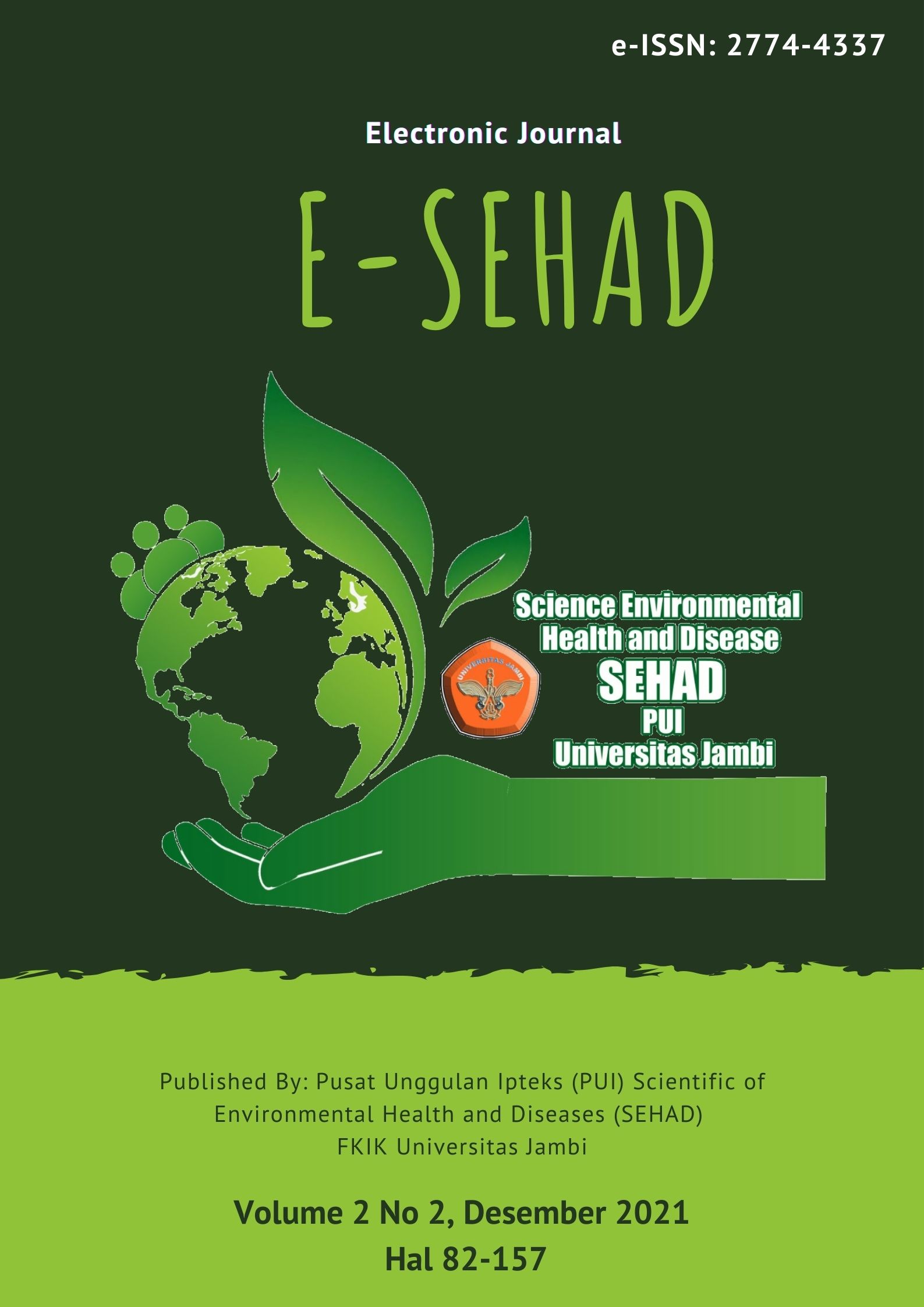OBESITAS DAN KEBUTUHAN ENERGI PADA KEHAMILAN
DOI:
https://doi.org/10.22437/esehad.v2i2.16915Keywords:
Obsitas, Energy for PregnancyAbstract
ABSTRACT
Deficiency or excess intake during pregnancy can be harmful to the fetus. Nutrition and energy in pregnant women determine the health of the mother and fetus. The fetus depends on its mother, for breathing, growth and to protect it from disease. Energy needs of pregnant women increase by 15% for the growth of the uterus, breasts, blood volume, placenta, amniotic fluid and fetal growth. The food consumed by pregnant women is used for fetal growth by 40% while 60% for the mother. If the fulfillment of energy in pregnant women does not meet the needs, there will be disturbances in pregnancy for both the mother and the fetus. Therefore, a comprehensive knowledge of energy requirements during pregnancy is needed based on medical science.
ABSTRAK
Kekurangan atau kelebihan asupan pada masa hamil dapat berakibat kurang baik bagi janin. Nutrisi dan energi pada ibu hamil sangat menentukan kesehatan ibu dan janin yang dikandungnya. Janin sangat bergantung pada ibunya, mulai dari pernapasan, pertumbuhan dan untuk melindunginya dari penyakit. Kebutuhan energi ibu hamil meningkat 15% untuk pertumbuhan rahim, payudara, volume darah, plasenta, air ketuban dan pertumbuhan janin. Makanan yang dikonsumsi ibu hamil dipergunakan untuk pertumbuhan janin sebesar 40% sedangkan 60% untuk ibu. Apabila pemenuhan energi pada ibu hamil tidak sesuai dengan kebutuhan, maka akan terjadi gangguan dalam kehamilan baik kepada ibu dan janin yang dikandungnya. Oleh karena itu diperlukan pengetahuan yang komprehensif terhadap kebutuhan energi selama kehamilan berdasarkan ilmu kedokteran.
Downloads
References
Kementrian Kesehatan RI. Riset Kesehatan Dasar (RISKESDAS). Jakarta; 2014.
Arisman. Gizi Dalam Kehidupan : Buku Ajar Ilmu Gizi. Jakarta: EGC; 2010.
Institute of Medicine. Nutrition During Pregnancy. Part I.Weight Gain. Washington, DC: Natl. Acad. Press; 1990.
Parker JD, Abrams B. Prenatal weight gain advice: an examination of the recent prenatal weight gain recommendations of the Institute of Medicine. Obstet Gynecol 1992;79(5 ( Pt 1)):664–9.
Schieve L. An Empiric Evaluation of the Institute of Medicine’s Pregnancy Weight Gain Guidelines by Race. Obstetrics & Gynecology 1998;91(6):878–84.
Abrams B, Altman SL, Pickett KE. Pregnancy weight gain: still controversial. The American Journal of Clinical Nutrition 2000;71(5):1233S-1241S.
Flegal KM, Carroll MD, Kit BK, Ogden CL. Prevalence of Obesity and Trends in the Distribution of Body Mass Index Among US Adults, 1999-2010. JAMA 2012;307(5):491.
Catalano PM. Management of Obesity in Pregnancy: Obstetrics & Gynecology 2007;109(2, Part 1):419–33.
Aune D, Saugstad OD, Henriksen T, Tonstad S. Maternal Body Mass Index and the Risk of Fetal Death, Stillbirth, and Infant Death: A Systematic Review and Meta-analysis. JAMA 2014;311(15):1536.
Metwally M, Ong K, Ledger W, Li T. Does high body mass index increase the risk of miscarriage after spontaneous and assisted conception? A meta-analysis of the evidence. Fertility and Sterility 2008;90(3):714–26.
Stothard KJ, Tennant PWG, Bell R, Rankin J. Maternal Overweight and Obesity and the Risk of Congenital Anomalies: A Systematic Review and Meta-analysis. JAMA 2009;301(6):636.
Catalano PM, Tyzbir ED, Allen SR, McBean JH, McAuliffe TL. Evaluation of fetal growth by estimation of neonatal body composition. Obstet Gynecol 1992;79(1):46–50.
Butte N, Caballero B. Energy needs: assessment and requirements [Internet]. In: Modern Nutrition in Health and Disease. Wolters Kluwer Health; 2006. page 136–48.Available from: https://library.biblioboard.com/content/d7522477-6f1f-4adf-902e-e4d1d17099a5
Caspersen CJ, Powell KE, Christenson GM. Physical activity, exercise, and physical fitness: definitions and distinctions for health-related research. Public Health Rep 1985;100(2):126–31.
Ainsworth BE, Haskell WL, Whitt MC, Irwin ML, Swartz AM, Strath SJ, et al. Compendium of Physical Activities: an update of activity codes and MET intensities: Medicine & Science in Sports & Exercise 2000;32(Supplement):S498–516.
Ainsworth BE, Haskell WL, Leon AS, Jacobs DR, Montoye HJ, Sallis JF, et al. Compendium of physical activities: classification of energy costs of human physical activities. Med Sci Sports Exerc 1993;25(1):71–80.
Prentice AM, Spaaij CJ, Goldberg GR, Poppitt SD, van Raaij JM, Totton M, et al. Energy requirements of pregnant and lactating women. Eur J Clin Nutr 1996;50 Suppl 1:S82-110; discussion S10-11.
Butte NF, King JC. Energy requirements during pregnancy and lactation. Public Health Nutrition [Internet] 2005 [cited 2018 Dec 24];8(7a). Available from: http://www.journals.cambridge.org/abstract_S136898000500131X
FAO/WHO/UNU expert consultation. Human energy requirements. In: Food and nutrition technical report series. Rome: FAO; 2004. page 53–62.
FAO/WHO/UNU Expert Consultation. Requirements during pregnancy. In: Energy and Protein Requirements technical report series. Geneva, Switzerland: WHO; 1985. page 84–7.
Hytten F. Nutrition. In: Clinical Physiology in Obstetrics. Oxford: Blackwell Sci; 1980. page 163–92.
Butte NF. Energy Requirements during Pregnancy and Consequences of Deviations from Requirement on Fetal Outcome [Internet]. In: Hornstra G, Uauy R, Yang X, editors. Nestle Nutrition Workshop Series: Pediatric Program. Basel: KARGER; 2005 [cited 2018 Dec 24]. page 49–71.Available from: https://www.karger.com/Article/FullText/82593
Coward W., Cole T. The doubly labeled water method for the measurement of energy expenditure in humans: risks and benefits. Bristol-Myers Nutrition Symposia 1990;9:139–76.


